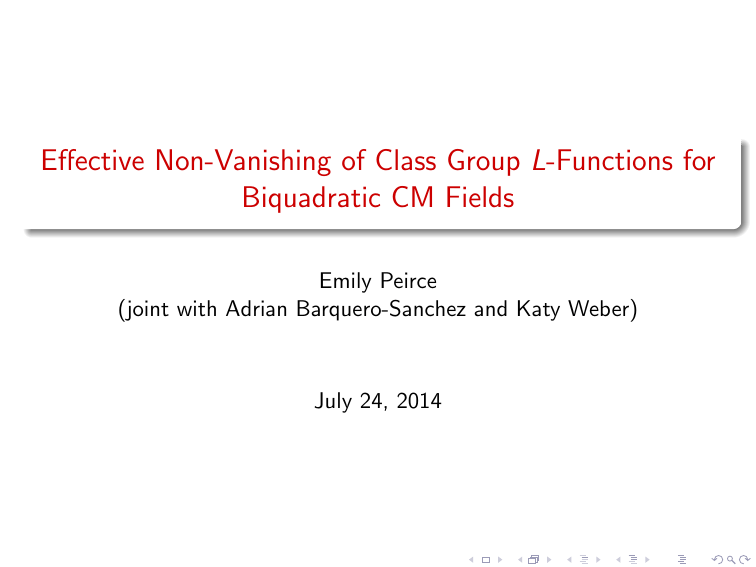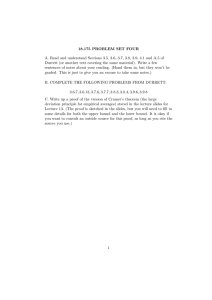Effective Non-Vanishing of Class Group L-Functions for Biquadratic CM Fields Emily Peirce
advertisement

Effective Non-Vanishing of Class Group L-Functions for Biquadratic CM Fields Emily Peirce (joint with Adrian Barquero-Sanchez and Katy Weber) July 24, 2014 Statement of Results Theorem (B-S, Peirce, W) Let d1 > 0 and d2 < 0 be square-free, co-prime integers with d1 ≡ 1 √ mod 4 and d2 ≡ 2 or 3 mod 4. Assume K = Q( d ) has class number 1 √ √ one and let E = Q( d1 , d2 ). Then if np o |d2 | ≥ C1 (d1 ) := (318310)2 d1 exp d1 (log(4d1 ) + 2) , 1 \ then there exists a character χ ∈ Cl(O 6 0. E ) such that L χ, 2 = Connection to Eisenstein Series Under our assumptions on K and E , the average formula becomes 1 hE X L(χ, 1 2) = \ χ∈Cl(O E) 2n d p 1 |d2 | !1 2 1 1 × EK (zOE , 2 ) [OE× : OK ] where the special point is zOE = p p d2 , d2 ∈ H2 . Connection to Eisenstein Series Under our assumptions on K and E , the average formula becomes 1 hE X L(χ, 1 2) = \ χ∈Cl(O E) 2n d p 1 |d2 | !1 2 1 1 × EK (zOE , 2 ) [OE× : OK ] where the special point is zOE = p p d2 , d2 ∈ H2 . From this formula, it suffices to show that EK (zOE , 12 ) 6= 0. Decomposition of the Eisenstein Series Proposition We have EK (zOE , 12 ) = M(d1 , d2 ) + H(d1 , d2 ) where M(d1 , d2 ) = 2 p 2RK π |d2 | √ log (|d2 |) − log − 2(γQ + log(4)) + 2γK d1 d1 and H(d1 , d2 ) = X p |d2 | X ∨ γ∈OK 06=ν∈OK cν (γy (zOE ))e 2πiTr (γνx) . The plan of the proof By the previous proposition and the reverse triangle inequality, |EK (zOd2 , 21 )| ≥ |M(d1 , d2 )| − |H(d1 , d2 )|. The plan of the proof By the previous proposition and the reverse triangle inequality, |EK (zOd2 , 21 )| ≥ |M(d1 , d2 )| − |H(d1 , d2 )|. Hence it suffices to show |M(d1 , d2 )| > |H(d1 , d2 )|. The plan of the proof By the previous proposition and the reverse triangle inequality, |EK (zOd2 , 21 )| ≥ |M(d1 , d2 )| − |H(d1 , d2 )|. Hence it suffices to show |M(d1 , d2 )| > |H(d1 , d2 )|. We will give an upper bound for |H(d1 , d2 )| and a lower bound for |M(d1 , d2 )|. An Upper Bound for |H(d1 , d2 )| Proposition If |d2 | ≥ (318310)2 d1 exp o np d1 (log(4d1 ) + 2) , then |H(d1 , d2 )| ≤ 6.80 × 10−401 . An Upper Bound for |H(d1 , d2 )| Proposition If |d2 | ≥ (318310)2 d1 exp o np d1 (log(4d1 ) + 2) , then |H(d1 , d2 )| ≤ 6.80 × 10−401 . The proof involves a very complicated argument to effectivize an upper bound of Bauer. A Lower Bound for M(d1 , d2 ) Proposition We have M(d1 , d2 ) > 1. A Lower Bound for M(d1 , d2 ) Proposition We have M(d1 , d2 ) > 1. The proof uses Ihara’s lower bound γK > −2(log(4d1 ) + 2)(log( p d1 ) − γQ − log(4π)) and the lower bound p RK > log(2 d1 ). Summary For |d2 | ≥ (318310)2 d1 exp o np d1 (log(4d1 ) + 2) , we have |H(d1 , d2 )| < 1 and M(d1 , d2 ) > 1. Summary For |d2 | ≥ (318310)2 d1 exp o np d1 (log(4d1 ) + 2) , we have |H(d1 , d2 )| < 1 and M(d1 , d2 ) > 1. Thus |M(d1 , d2 )| > |H(d1 , d2 )|, implying |EK (zOE , 12 )| > 0. Summary For |d2 | ≥ (318310)2 d1 exp o np d1 (log(4d1 ) + 2) , we have |H(d1 , d2 )| < 1 and M(d1 , d2 ) > 1. Thus |M(d1 , d2 )| > |H(d1 , d2 )|, implying |EK (zOE , 12 )| > 0. \ Hence, by the average formula, there exists a χ ∈ Cl(O E ) such that 1 L(χ, 2 ) 6= 0. Example Choose d1 = 5. Example Choose d1 = 5. Then C1 (5) = 2.77028 × 1013 . Example Choose d1 = 5. Then C1 (5) = 2.77028 × 1013 . Hence for all |d2 | ≥ 2.77028 × 1013 , there exists a χ such that L(χ, 12 ) 6= 0. Some Remarks The restrictions on d1 and d2 were made to simplify the presentation. Some Remarks The restrictions on d1 and d2 were made to simplify the presentation. A version of the main result holds for any CM extension E of K when K has class number one. Some Remarks The restrictions on d1 and d2 were made to simplify the presentation. A version of the main result holds for any CM extension E of K when K has class number one. One has reduced the question of the existence of non-vanishing L(χ, 21 ) to a (large!) finite calculation.







